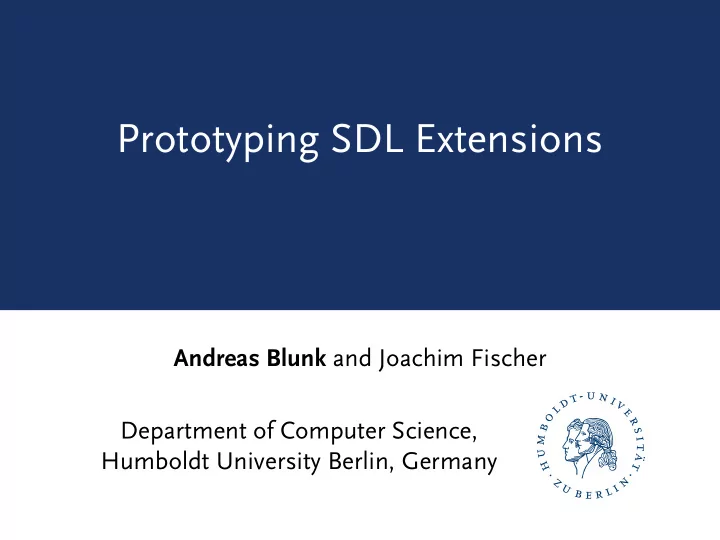

Prototyping SDL Extensions Andreas Blunk and Joachim Fischer Department of Computer Science, Humboldt University Berlin, Germany
Outline • Approach Overview • Contribution • Approach Details • Application to SDL • Summary 2
Overview Import Extension Definition • An approach for extending a base language by more specific concepts Base Language • Supports iterative development • Automatically provides tools at each stage introduce concept - Textual editor (modeling) (more concise, - Runtime e ffi cient next-event simulator comprehensible) (model analysis) • Allows to evaluate design and suitability of a new concept discover • can be directly used in models modeling pattern • evaluate the performance of a system modeled • Simple example: pattern for iterating over list data structure • Prototyping useable for small concepts (for- each), aim for Domain-specific Languages (DSLs) Use Extension 3
Contribution • We understand SDL as a DSL - Specific concepts for modeling structural and functional aspects of communication systems - General concepts regarding the domain itself - If domain gets more specific, e.g. real-time systems, more specific concepts may be needed - Examples of proposed SDL extensions: SDL-RT Semaphores , Process Priorities, Real-Time Tasks (without integrated tool support) • Goal - Apply the approach to SDL as an archetype - Get confidence for possible successful applications to other DSLs 4
Approach • Approach is targeted towards - DSLs which are used for model analysis by next-event simulation (simulation languages for certain domains) • Discrete-Event Base Language (DBL) - OO language + process-oriented event specification primitives (ESP) • ESP: active/passive objects, consumption of model time, blocking wait & reactivate as part of an active object life cycle - Execution: DBL —(map-to)—> DBL Core (C++ & Simulation library) - DBL Core: novel context switch approach in C++ with low execution time [SpringSim14], close to Assembler - Runtime e ffi ciency: important requirement for simulation studies • Implementation: DMX - Discrete-Event Modeling Framework with Extensibility 5
Approach • Implemented Parts - Textual syntax [SAM Innsbruck]: BNF-like Object grammar - Execution Semantics [Forum Montréal]: Mapping to DBL generates code as text - Nested extensions - Extension in extension - Extension in extension definition - Executable DBL to Java/Sim mapping • Open Parts - Technical: executable DBL to C++ DBL Core mapping - Conceptual challenges … 6
Application to SDL • Subset SDL 0 - Definitions of system, process, signal, variable, timer, simple states and transitions (signal, timer, none), tasks output, set/reset timer - DBL concepts reused: variable, statement (task), expression (values, timers) - Minor issues (details in paper) • (SDL-RT) Semaphores - Semaphore Definition + Take & Give Actions - Issue: Concepts cannot be defined modular • SDL 0 + Semaphores defined in one big extension • Actually, Semaphores are an extension of certain concepts of the SDL 0 extension • Take/Give extend SDL Task • Semaphore Definition extends Entity Definition • Requires expression means for further extensibility of extensions • Syntax is simple, but semantics are di ffi cult 7
Application to SDL-RT Semaphores • Benefits of the extension-based definition • Modeling assistance for added concepts • Semantics can be defined by using event specification primitives • Runtime e ffi cient next-event simulations • Issue regarding another important application of SDL • Code generation to platform-specific concepts, e.g. real time operating systems • SDL/Semaphores —(map-to)—> DBL —(map-to)—> C++/ Sim • Parallel processes —(executed)—> Sequentially as pseudo-parallel processes • DBL —(map-to)—> C++/Threads may be feasible 8
Summary • Approach for prototyping new language concepts • Extension-basis allows to reuse general concepts • Application to SDL subset and SDL-RT Semaphores • Supports the initial design phase by providing low cost tools • Concepts can be directly used in models • Evaluate the performance of a system modeled 9
Recommend
More recommend